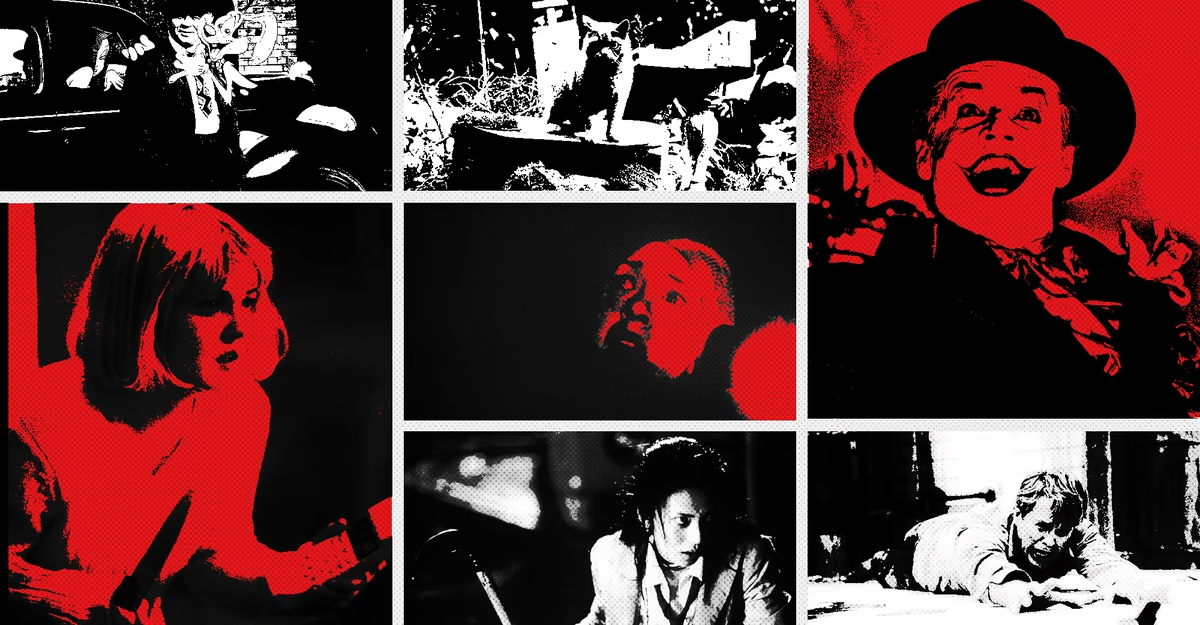Nine Movies That Break Down How Fear Really Works

Updated at 1:30 p.m. ET on Oct. 30, 2025
Part of the fun of asking someone what movies scare them is that the answers tend to be unpredictable. Fear is individual, specific, and deeply felt: A person made anxious by the ocean may not be able to bear watching Jaws but be totally fine with the monsters-loose-on-an-island premise of Jurassic Park. Sometimes, a frightened reaction is inexplicable. But the most terrifying films are the ones that force us to question why we’re so afraid at all—and what makes the image or moment on-screen so effective.
The nine movies below do just that. They illuminate our unease in the way only cinema can. Stylistically and tonally, they run the gamut—some evoke a creeping sense of dread, and others offer more blunt provocation. Some find the dark contours of comedy; others masterfully deploy pathos. The one quality they share: They really, truly scared us.
Everett Collection
Batman (1989, directed by Tim Burton)
I was a latchkey kid with an older brother, and so growing up was regularly terrorized by age-inappropriate movies. But the most indelible by far was Tim Burton’s 1989 Batman, which I watched at the age of 6 or 7 and proceeded to lose sleep over for the next half decade. Unlike Cesar Romero’s Joker from the child-friendly TV Batman, cheery and inane, Jack Nicholson’s version is fully monstrous—sneering and sadistic, his dead eyes obscene next to his rictus grin. But the quality that terrified me the most in the Joker was his unpredictability. He’s an unexploded bomb, a hyena with a machine gun. His art form is chaos, and the unrestrained fear that chaos can provoke. (The Joker’s supermarket stunt, in which he tells the people of Gotham that their toiletries will kill them, but not which ones, exploits exactly that sense of tumult.) I’ve grown up enough to be able to appreciate Batman as a work of cinema but am still regularly terrified by volatility. — Sophie Gilbert
How to watch: Stream on HBO Max
Buena Vista / Everett Collection
Who Framed Roger Rabbit (1988, directed by Robert Zemeckis)
Squint and it might seem like a film for kids. I’m guessing that’s why one of my first moviegoing memories is watching, from behind my fingers, Who Framed Roger Rabbit. In truth, it’s a nervy noir about humans living alongside toons in not-so-perfect harmony, a world where twisted zeal and greed hide shocking secrets. Live action and animation come together in mind-bending ways, in service of the titular mystery. What really got me was the movie’s last act, which exposes a conspiracy involving the villainous Judge Doom and a paint-thinner-ish goo called Dip that’s lethal just to toons. The implication of the goo was terrifying: It meant that the toons, those physics-defying ink-and-paint characters that could seemingly survive anything, were, in fact, mortal. I didn’t understand then why that scene was so chilling, but now I recall it as the first time that I saw a film’s form—in this case, the mixed-media approach that makes the toons’ vulnerability so clear—completely transform my emotional response to a story. — Jane Kim
How to watch: Stream on Disney+
Dimension Films / Everett Collection
Scream (1996, directed by Wes Craven)
As a preteen who was just starting to get into movies, I was unmoved by the meta-textual part of Scream’s premise—that it is an ironically faithful send-up of the horror genre itself. I didn’t care that the masked murderer was operating by the storytelling “rules” of slasher movies; I was just alarmed that he could break into your house with a knife. Such is the brilliance of Wes Craven’s self-aware spin on serial-killer tropes, which manages to both mock a generation of teenagers raised on the campy likes of Friday the 13th and deliver honest scares in its own right. The opening sequence, in which a teen (played by Drew Barrymore) is terrorized by the Ghostface killer while she is home alone, is the most unsettling scene Craven ever delivered in a storied career: an extended, torturous guessing game by phone that makes the audience sit in the tormentee’s sense of terror. It awakened me to the unsettling permeability of our homes, ostensibly our safest spaces—any window or door could be breached by a bloodthirsty stranger in the night. — David Sims
How to watch: Stream on Paramount+, Peacock
Moviestore Collection Ltd / Alamy
Akira (1988, directed by Katsuhiro Otomo)
I love Akira, despite the distressing lesson it taught me: that a movie could induce an intensely physical reaction. The 1988 cyberpunk anime is far from a realistic tale; Tokyo, in 2019, is still recovering from a psychically induced cataclysm three decades prior. As the government works to capture anyone with telekinetic powers capable of such devastation, gang violence and corruption overrun the city. This dystopia is entrancing on-screen, thanks to meticulous animation; the film is rightfully considered one of the medium’s most impressive feats. Unfortunately for the squeamish 12-year-old me, the lifelike fluidity intensifies the story’s body-horror elements. Over the course of the movie, a psychically gifted teen breaks down under the weight of his abilities—most viscerally in a sequence in which his body, seemingly completely out of his control, mutates into an ever-growing mass of flesh. Akira luxuriates in the scene’s nauseating sounds, and the visual transformation is almost tactile. Twenty years after I first watched it, I still swear I can feel phantom pains. — Allegra Frank
How to watch: Stream on Crunchyroll
Paramount / Everett Collection
Pet Sematary (1989, directed by Mary Lambert)
At 14, I was on what already was a years-long project of devouring most of Stephen King’s work (my reading stamina owes everything to The Stand, unabridged), and I firmly believed horror movies no longer held sway over my dreams. I was wrong—after watching Mary Lambert’s adaptation of Pet Sematary, I couldn’t sleep for days. In the film, a cat is hit by a car and resurrected via a secret burial ground. It returns to its family, alive but not quite right. When the family’s youngest child dies, his father feels that he has only one choice: to bury his son in the same cursed place, knowing full well the consequences. The situation devolves from there, in a sort of micro-zombie apocalypse. The desire for loved ones to return after their death is deeply human, driving mourners so far as to hallucinate the deceased into existence. King’s unshakeable ghost story doubles as a thesis for the genre’s existence: I think we see ghosts because we want to believe that the dead can be revived, and we fear ghosts because we know they can’t. — Boris Kachka
How to watch: Stream on Paramount+
Mary Evans / Toei Co / Ronald Grant / Everett Collection
Battle Royale (2000, directed by Kinji Fukasaku)
Battle Royale, the dystopian thriller in which junior-high students must kill one another as part of a state-mandated “game,” is perhaps best known for having extremely limited distribution outside Japan for years because of its violence. But when I watched it at age 8 off a bootleg Chinese DVD, I was most disturbed by how easily the characters—played by a cast of young adults themselves—descend into emotional cruelty: the way best friends fall apart over small misunderstandings, how trivial gossip foments lethal paranoia and resentment. Teenagedom, as a result, terrified me. I entered high school determined to be liked; by peppering natural, often unexpectedly earnest dialogue with sudden bursts of brutality, the director Kinji Fukasaku so effectively conveyed the horrors of juvenile angst that I feared angering the wrong peers, and the real frictions of growing up. Yet that depth is what makes Battle Royale so haunting. It’s more than merely a horror classic; it’s a coming-of-age one too. — Shirley Li
How to watch: Stream on Prime Video
Dimension Films / Everett Collection
The Blair Witch Project (1999, directed by Daniel Myrick and Eduardo Sánchez)
Most of the mythos that launched The Blair Witch Project to cult status—its use of supposed found footage, a marketing campaign that involved faux missing-person posters—had faded by the time I first watched it, around 2013. But watching the three students, armed with a shaky camcorder, hunt for the titular spirit, I found my assumed familiarity fading into dread. The film asserts itself as the remaining record of the filmmakers, who disappeared; what was then an eerie idea is now an unnerving reality. The internet has existed for long enough to be littered with artifacts of the missing and dead—photos, videos, posts. The Blair Witch Project, with its pseudo-documentary conceit, portended today’s digital voyeurism: I knew that things would end badly for these young people, but I also couldn’t look away. — Elise Hannum
How to watch: Rent on Prime Video and YouTube
Lions Gate / Everett Collection
Saw (2004, directed by James Wan)
The woman with a reverse bear trap locked around her head lives on in my mind: Bulky and menacing, the metal contraption threatens to rip her jaw apart unless she can find a key that will unlock it. It’s a striking visual; even thinking about it makes the corners of my mouth itch. It’s also exactly the kind of image that most people remember about Saw, the 2004 movie that spawned about a gazillion grisly sequels. But the original film’s scares succeed because of their tension—how the story drags out the inevitable over nearly two excruciating hours. The main characters, who wake up chained to pipes, quickly realize amputating their own foot is the only means of escape. It takes much longer for their other efforts to fail, one by one. In Saw, the strongest fear may not be the threat of an outside villain endangering your life but how far you may have to go to save it. — Serena Dai
How to watch: Stream on Hulu
Sony Pictures / Everett Collection
Click (2006, directed by Frank Coraci)
Underneath this Adam Sandler comedy’s goofy jigs and fart jokes is a compilation of emotional horrors as potent as any jump scare. At a Bed, Bath & Beyond, Sandler’s protagonist happens upon a remote control that can manipulate the universe—which he uses to fast-forward through minor inconveniences such as traffic jams and to anticipated milestones such as work promotions. In the style of a Greek tragedy, the film goes on to depict protracted, ever-escalating scenes of misfortune: Sandler’s character skips over decades of his life, missing his kids’ childhoods and the everyday texture of his marriage. When I watched this movie in elementary school, it introduced me to an existential terror of living life on autopilot, to the harrowing brevity of human existence, and to the real cost of chasing goals at the expense of nurturing relationships. — Valerie Trapp
How to watch: Stream on Hulu
This article originally misstated the events of a scene in Saw. A woman must prevent a reverse bear trap from opening.
*Illustration by Jonelle Afurong / The Atlantic. Sources: Artisan Entertainment / Everett Collection; Buena Vista / Everett Collection; Dimension Films / Everett Collection; Everett Collection; Lions Gate / Everett Collection; Mary Evans / Toei Co / Ronald Grant / Everett Collection; Paramount / Everett Collection.





